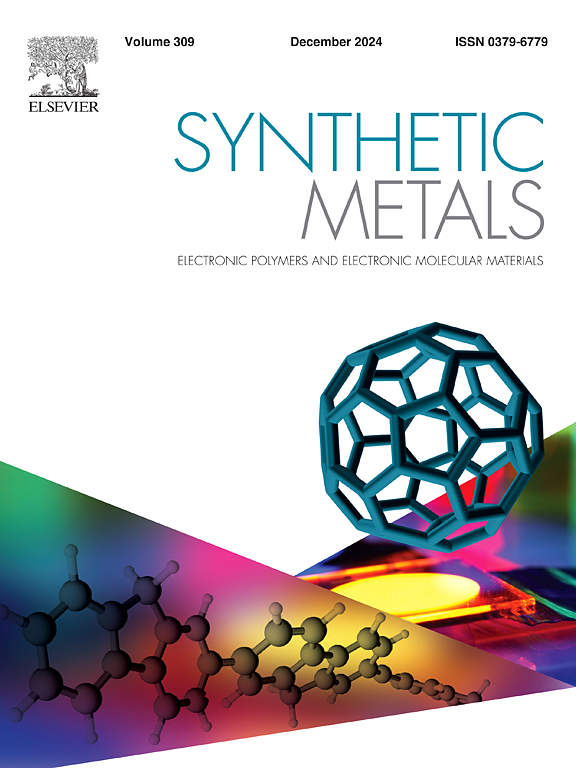Green solvent-processable poly(3-hexylthiophene) derivative maintains high hole mobility in diodes
IF 4.6
3区 材料科学
Q2 MATERIALS SCIENCE, MULTIDISCIPLINARY
引用次数: 0
Abstract
The development of environmentally sustainable fabrication methods for organic solar cells (OSCs) is critical to enable their large-scale adoption. Conventional solution-processed OSCs often rely on halogenated, toxic solvents that pose health and environmental risks, limiting their scalability. This is because π-conjugated polymers tend to have a low solubility in non-halogenated solvents. A common strategy to enhance solubility in alternative solvents is through the incorporation of polar solubilizing groups, often on every repeat unit of at least one monomer. However, too many polar side chains tend to disrupt favorable morphology and decrease charge transport properties. In this study, we demonstrate that a minimal degree of side chain functionalization can improve green solvent processability while preserving electrical performance. We tested this hypothesis using our previously reported random copolymer derivative of poly(3-hexylthiophene) (P3HT) where ∼10 mol% of the side chains are 6-pentanoatehexyl side chains. We find that this low-level functionalization significantly broadens the solvents that can be used to process P3HT to less toxic solvents such as o-xylene and anisole. Furthermore, the copolymer processed from greener solvents showed high hole mobilities (∼10⁻3 cm2/Vs by the Space-Charge Limiting Current method in diodes), comparable to P3HT films cast from toxic chloroform. These findings suggest that minimal side-chain modification is a viable strategy for expanding green solvent compatibility while preserving electrical performance, paving the way toward more sustainable organic semiconductor designs.
绿色溶剂可加工聚(3-己基噻吩)衍生物在二极管中保持高空穴迁移率
开发环境可持续的有机太阳能电池(OSCs)制造方法对于实现其大规模应用至关重要。传统的溶液处理osc通常依赖于对健康和环境构成风险的卤化有毒溶剂,限制了其可扩展性。这是因为π共轭聚合物在非卤化溶剂中具有较低的溶解度。提高在替代溶剂中的溶解度的一种常用策略是在至少一个单体的每个重复单元上加入极性增溶基团。然而,过多的极性侧链往往会破坏有利的形态,降低电荷输运性质。在这项研究中,我们证明了最小程度的侧链功能化可以提高绿色溶剂的可加工性,同时保持电气性能。我们使用之前报道的聚(3-己基噻吩)(P3HT)的随机共聚物衍生物来验证这一假设,其中约10 mol%的侧链是6-戊烷己基侧链。我们发现,这种低水平的功能化显著拓宽了可用于将P3HT加工成毒性较小的溶剂(如邻二甲苯和苯甲醚)的溶剂范围。此外,由绿色溶剂加工而成的共聚物显示出高空穴迁移率(通过二极管的空间电荷限制电流法~ 10⁻3 cm2/Vs),与由有毒氯仿制成的P3HT薄膜相当。这些发现表明,最小的侧链修饰是一种可行的策略,可以在保持电气性能的同时扩大绿色溶剂相容性,为更可持续的有机半导体设计铺平道路。
本文章由计算机程序翻译,如有差异,请以英文原文为准。
求助全文
约1分钟内获得全文
求助全文
来源期刊

Synthetic Metals
工程技术-材料科学:综合
CiteScore
8.30
自引率
4.50%
发文量
189
审稿时长
33 days
期刊介绍:
This journal is an international medium for the rapid publication of original research papers, short communications and subject reviews dealing with research on and applications of electronic polymers and electronic molecular materials including novel carbon architectures. These functional materials have the properties of metals, semiconductors or magnets and are distinguishable from elemental and alloy/binary metals, semiconductors and magnets.
 求助内容:
求助内容: 应助结果提醒方式:
应助结果提醒方式:


